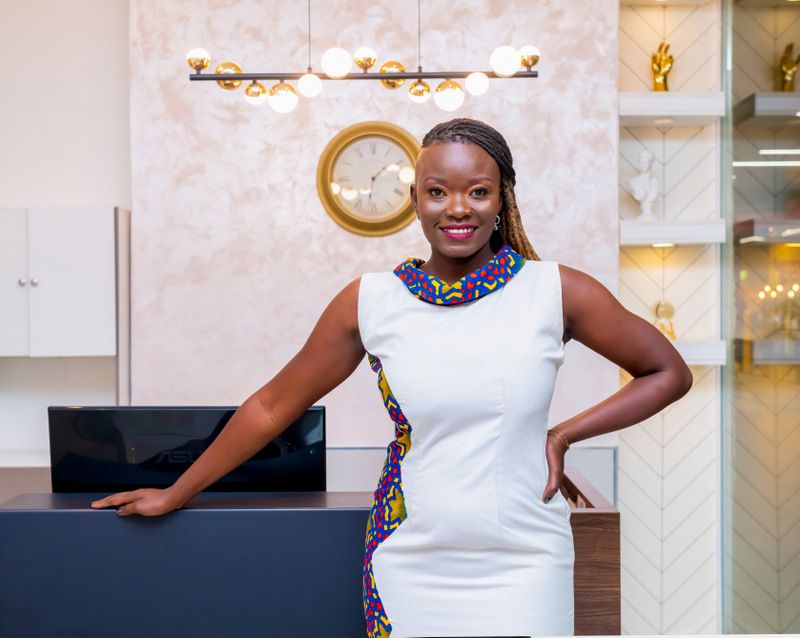News
Ebby Weyime Is Elevating Period Care
Story by Atieno Odera for bird story agency

For a biological process that impacts and unites women worldwide, it disturbed Ebby Weyime that the range of menstrual products available on the shelves was so limited. She had already tried sanitary pads and tampons, the alternatives available on the market, and though they served the purpose, they made her uncomfortable.
“Both of these products were not working for me. Single-use pads have a plastic lining, which was leaving me with a skin rash and a high risk for infections,” said Weyime.
She, therefore, turned to the internet to look for a better option. What she found baffled her.
“When I saw the menstrual cup, my first thoughts were, ‘What a strange-looking thing! This is ridiculous! How am I supposed to insert this inside my vagina? It looks like another problem, not a solution.'”
Despite her questions, she took a leap of faith and placed an order to try it out.
“Though it looked strange, the flexible silicone it was made from made it so comfortable to use. Finally! This was it!” she said.
After her experience, Weyime started thinking about all the other girls and women struggling with uncomfortable pads and tampons.
It was time to bring a new experience to this table, and the Grace Cup venture was born in 2017.
“I had just returned from South Africa and had some savings from my previous job there, but the money was not enough to set up the business. I had already tested the waters by starting with two cups and selling them to my friends, who loved them. So I went ahead and asked my parents for a loan, got the supplies from China, and started selling from my mother’s house. I knew that it was a completely new concept, especially in Kenya at that time, and it would take some time to penetrate the market,” shared the fashion model and actress.

The reusable, bell-shaped cups, which she imports from China and Canada, are made from flexible medical-grade silicone and have a stem that helps during insertion and removal. Unlike tampons that absorb menstrual blood, a menstrual cup is inserted in the vagina and collects the blood. It can be used for up to 12 hours, after which it’s removed to dispose of the fluid and cleaned.
The cup is rinsed with hot water after every use, and at the end of the monthly period, it’s sanitized by boiling it in water for five to 10 minutes. By 2019, Weyime had made enough money to pay back the loan and hire two full-time employees and a few others part-time.
But there were some problems when the menstrual cup was brought to the Kenyan market.
“The reception was tough in the early days because people did not know what a cup was, and telling people to insert a cup inside the vagina was very difficult,” she explained.

She also leveraged social media to increase the cup’s visibility.
“Social media is my main marketing tool, and I have been able to expand my reach to over 12,000 followers. Client referrals have also gone a long way,” she shared.
When one of her clients, Muthoni Chege, started using the Grace menstrual cup in 2019, she thought it would break her virginity.
“I was a bit worried about inserting the cup at first because I was a virgin. I thought it would break my hymen. So Ebby advised me to start with the small, 10-millilitre antibacterial cup. It’s the best for beginners,” the 23-year-old said.
“At first, it was tricky. The insertion was different from tampons. The first few times were hard, but by the third month, I had gotten a grip on it,” added the college student.
Muthoni says that now she can sleep all night with the menstrual cup; she doesn’t have to change it every four hours like the tampons she previously used; and she’s also stopped experiencing cramps.
“I used to experience severe menstrual cramps when I was still using the other products. Since I started using the cup, the cramps have completely disappeared,” she said.

But it’s more than menstrual cups that Weyime’s company deals with. She also has reusable pads.
“The reusable pads sell for 1,250 shillings (US$10) for a bag containing four pads. These pads can be reused for up to three years. The menstrual cup sells for 2 000 shillings (US$17), and the single cup is reusable for up to 10 years. To some people, a single purchase might seem like a considerable amount, but if you break this into monthly purchases, you will see that it’s very affordable,” she shared.
On average, Kenyan women spend between Ksh100 and Ksh200 on disposable (single-use) menstrual pads monthly. For Weyime, the Grace Cup is much more than a money-making venture.
“We are bringing in a product that makes menstruating a better and more affordable experience and is also environmentally friendly. Because it doesn’t matter where you grew up, there are places where you’ve met a used pad and wondered what it was even doing there. Poor disposal of these products has been a menace that we have faced for a long time,” she explained.
Each year, millions of tampons and pads are either thrown out as solid waste or end up in the water systems if they are flushed down the toilet. If disposed of as solid waste, they end up in landfills, where they are estimated to take as long as 500 years to break down. This is of major concern to many women, who might use and dispose of between 5,000 and 15,000 pads and tampons in their lifetime.
Weyime believes that if only 15 per cent of Kenyan women embraced reusable products, the move would significantly impact the disposal problem and create a safer environment for all.





















